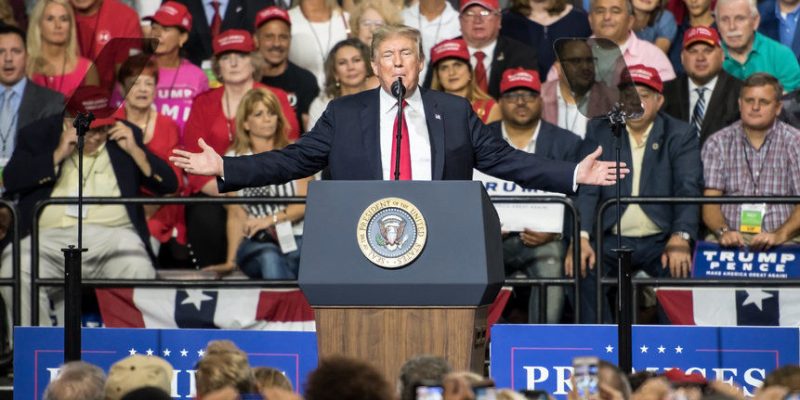
As the 2024 US presidential election approaches, the economy is front and center in political debates, as it always is during election cycles. Historically, voters have associated economic growth and prosperity with Republican candidates, particularly former President Donald Trump.
For years, Trump maintained a significant edge in voter trust when it came to handling the economy.
However, recent polling data suggests that his advantage has shrunk dramatically, and in some cases, Vice President Kamala Harris is closing the gap altogether.
The US economy is performing better than expected, and this economic optimism seems to be affecting voter sentiment in ways that neither Trump nor many Republicans anticipated.
How is the US economy really doing in 2024?
To understand the shift in voter sentiment, we must first look at the current state of the US economy.
By many measures, the economy has been performing exceptionally well despite persistent challenges. Inflation, a key concern for voters throughout 2022 and 2023, has cooled significantly.
The Federal Reserve’s aggressive interest rate hikes, once feared to induce a recession, have resulted in what experts are calling a “soft landing.”
In fact, inflation is now close to the Fed’s 2% target, allowing it to cut interest rates—something that brings welcome relief to borrowers across the country.
The labor market has remained resilient, with the latest jobs report showing a robust addition of 254,000 jobs in September.
Even more promising, wage growth for American workers has outpaced inflation for over a year, increasing purchasing power for many households.
These improvements are helping to reduce the “sticker shock” that voters felt during the previous inflationary period.
While inflation remains a hot-button issue in public discourse, the actual impact on everyday life is decreasing.
This shift is contributing to a more positive outlook among voters, especially those who had previously felt squeezed by rising costs.
What are Trump’s economic proposals for 2024?
Trump’s economic agenda for 2024 presents a mix of familiar policies and new, more radical ideas.
Central to his platform are sweeping tax cuts, targeting not just corporations and high earners, but also income from overtime pay, tips, and pensions.
Trump is also proposing to remove the cap on state and local tax (SALT) deductions, a move favored by wealthier homeowners in suburban areas.
But one of the most controversial aspects of his platform is the imposition of heavy tariffs on imported goods.
Trump has floated ideas of a 20% tariff on all imports, and a massive 60% tariff specifically on goods from China.
He argues that these tariffs would protect American manufacturing jobs and raise revenues that would fund the tax cuts.
However, economists widely agree that these tariffs would raise prices for US consumers, as companies would pass on the increased costs of imported goods.
In essence, this would function like a national sales tax, disproportionately affecting low- and middle-income households.
A report by the Peterson Institute for International Economics estimates that these tariffs could cost the average US household an additional $2,600 annually.
Why is Trump losing ground on the economy?
Given Trump’s long-standing reputation as a businessman who understands how to grow the economy, why is his lead on this issue slipping?
The first reason is that Trump’s economic proposals, especially his tariff policies, are increasingly viewed as economically risky by many voters.
While his base may still support protectionist measures, there’s growing concern that such policies could ignite inflation once again, undermining the economic progress made in recent years.
Independent analyses suggest that Trump’s plans could raise consumer prices and potentially harm economic growth—an argument that is beginning to resonate with voters who remember the impact of past trade wars.
Adding to the concern is the potential impact of Trump’s plans on the national debt.
According to the Committee for a Responsible Federal Budget (CRFB), Trump’s economic agenda is projected to raise the federal debt by $7.5 trillion through 2035, roughly double the $3.5 trillion increase expected under Kamala Harris’s platform.
The CRFB warns that Trump’s proposed tax cuts, tariffs, and immigration policies could significantly strain US finances, raising the debt to 142% of GDP.
This increase in borrowing could risk triggering a fiscal crisis, slow economic growth, and weaken national security.
Such concerns about long-term fiscal responsibility are making some voters reconsider the viability of his economic approach.
Another reason is that his stance on immigration and the US-China relations is fueling economic concerns.
It is projected that Trump’s proposed mass deportations could reduce the US GDP by more than 3% by 2028, disproportionately affecting states like California, Texas, and Florida that rely heavily on migrant labor.
Meanwhile, his plan to impose up to 60% tariffs on Chinese imports risks severely disrupting the US-China trade, potentially ending the economic relationship between the two countries.
These policies add to the perception that his economic approach might be too volatile to maintain stable growth.
Lastly, Trump’s messaging has been inconsistent. Instead of focusing on concrete economic policies during campaign events, he has often veered into unrelated topics, such as his infamous Michigan speech where he claimed to have won a fictional “Michigan man of the year” award.
Such distractions do little to reassure voters who are concerned about the future of the economy.
In contrast, many believe that Kamala Harris has managed to communicate a more straightforward and relatable economic message.
While her policy platform is aligned with many of President Joe Biden’s initiatives—such as increased taxes on the wealthy, manufacturing subsidies, and an expanded child tax credit—she has shifted the focus toward cost-of-living issues, which are more forward-looking and resonate better with middle-class voters.
Her emphasis on reducing everyday costs like healthcare, housing, and childcare has struck a chord with many who feel the pain of rising living expenses.
Are voters simply feeling better about the economy?
Beyond the candidates’ policies and messaging, the simplest explanation for Trump’s shrinking lead on the economy may be that the US economy is performing well enough to soothe voter concerns.
As inflation continues to stabilize and wages rise, voters are beginning to feel the benefits of a recovering economy.
Consumer sentiment has risen 40% from its low in June 2022, according to the University of Michigan’s consumer survey.
This newfound optimism may be undermining Trump’s narrative that the Biden-Harris administration has mismanaged the economy.
Voters may also be growing tired of Trump’s dire warnings about economic doom when they are experiencing improvements in their own financial lives.
The gap between voter perceptions of the economy and objective economic data is narrowing, and that shift benefits Harris.
What’s next for Trump and Harris?
With five weeks left until the election, both Trump and Harris have significant work to do.
For Trump, the challenge is to refocus his campaign on economic policies that appeal to middle-class voters without alienating them with protectionist measures that could increase costs.
He will also need to provide clearer and more consistent messaging on how he intends to fix the issues facing American workers.
Harris, on the other hand, must continue to capitalize on the economic momentum.
If the positive economic trends hold and she can maintain a steady narrative on reducing living costs, she stands a strong chance of closing the gap even further.
Her challenge will be convincing voters that the progress made so far can be sustained and expanded under her leadership.
Overall, the US economy has always played a decisive role in presidential elections, and 2024 is no exception.
While Trump’s economic proposals once resonated with voters, the strong performance of the current economy undercuts his message.
Voters are beginning to see through the complexities of tariffs and protectionism and are instead focusing on immediate concerns like the cost of living and job security.
As US citizens continue to feel the benefits of a recovering economy, Trump may find that his once-commanding position on economic issues is no longer enough to guarantee victory.
The post Trump’s economic strategy for 2024 is fading — here’s what voters are seeing appeared first on Invezz











